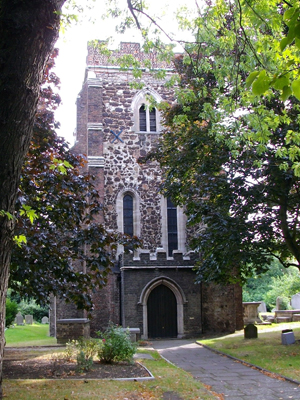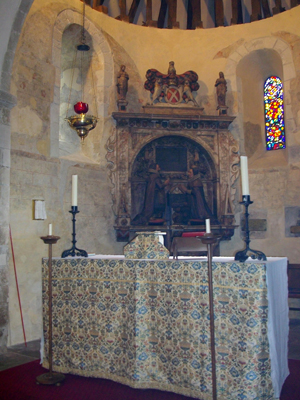| |
 |
 |
 |
| Comment on this report, or find other reports. |
 |
| Our Mystery Worshippers are volunteers who warm church pews for us around the world. If you'd like to become a Mystery Worshipper, start here. |
 |
| Find out how to reproduce this report in your church magazine or website. |
|
|
| 2045: St Mary
Magdalene, East Ham, London |
 |
 |
 |
Mystery Worshipper:
Salskov.
The church:
St
Mary Magdalene, East Ham, London.
Denomination:
Church of England, Diocese
of Chelmsford.
The building:
The present Norman church was built around 1130, and the tower
in the 13th century, though much of it dates from the 16th century.
A variety of materials went into this church: Caen stone from
Normandy, flints and chalk from Purley, Kentish rag, as well
as local pudding stone, can still be seen in the walls. The
west door is Victorian. The comprehensive virtual tour on the
website doesn't really give a true impression of the charm of
the church interior. Original wall paintings were uncovered
and preserved about three years ago, of the kind sometimes to
be found in Cistercian buildings. Sadly, the lovely stained
glass was destroyed during World War II. There are deeply splayed
Norman lancet windows as well as the larger Victorian ones.
Behind the altar is a vividly coloured lancet widow of slab
glass that dates from 1972. The sanctuary also holds a Jacoben
monument to the Neville family, a piscina, and a Flemish Renaissance
statue of the patronal saint, Mary Magdalene. Finally, there
is an anchorite's cell, with a hatch through which the inhabitant
could talk to visitors and take communion.
The church:
East Ham is part of the London immigrant corridor. It has seen
the arrival of the 19th century Jewish population, Asians, West
Indians, Africans, and more recently European Economic Community
members from Poland and elsewhere. St Mary Magdalene reflects
this cultural variety. The level of unemployment is high, but
the spirit of community is strong. This element of social cohesion,
so powerful in the old East End makeup, lives on in the churches
of the area, reinventing itself as the demographic changes from
year to year.
The neighbourhood:
There was a Roman cemetery close by this ancient site. The coffins
discovered there in 1864 are now in the British Museum.
The cast:
The Revd Quintin Peppiatt.
The date & time:
Sunday, 15 August 2010, 10.00am.
What was the name of the service?
Parish Eucharist.
How full was the building?
In this tiny church, which probably seats 100 max, I counted
51 in the congregation, one priest, six in the procession, and
one organist. A fine mix of ages and nationalities.
Did anyone welcome you personally?
A lady standing just outside the door said hello. Another handed
me the hymn book and service sheet. Revd Peppiatt came up and
shook my hand and asked me where I was from (as it happens,
I'm local, but am hardly ever around on Sundays).
Was your pew comfortable?
The pews are of unadorned wood, but sufficiently deep front
to back to be quite comfortable. There are heating panels faced
in matching wood in the back of each pew, which are probably
more efficient than either the stoves or the original fireplaces!
How would you describe
the pre-service atmosphere?
There was quite a lot going on. Some people chatted, the children
moved about, and the organist was rehearsing his tiny choir
of four singers at the back of the church: three adults and
a boy. He later played a medley of hymn tunes.
What were the exact opening
words of the service?
"In the name of the Father, and of the Son, and of the
Holy Spirit. Welcome to you all and to our visitors."
What books did the congregation use during the
service?
The parish eucharist service booklet and Complete Anglican
Hymns Old and New.
What musical instruments were played?
Organ. In the days when there was a gallery at the west end
of the church, there was a barrel organ played by the then schoolmaster.
After the removal of the gallery, a "positive" organ was installed.
The current instrument was bought after the first World War
in memory of a curate and is still in use today at the west
end of the church.

Did anything distract you?
The incense. I like it, but being in the recovery stage of a cold, I found that it caught in my throat and made me cough.
Was the worship stiff-upper-lip, happy clappy, or
what?
Fully vested, domestic ceremonial, but relaxed, especially in the sermon. See below.
Exactly how long was the sermon?
15 minutes.
On a scale of 1-10, how
good was the preacher?
5 – The service up to that point had been visually traditional
and in keeping with the historic surroundings. We suddenly leaped
forward a couple of centuries, and a screen appeared for a slide
show. Revd Peppiatt joked about getting the equipment to work.
There was a good deal of laughter, especially when his assistant
forgot to project the next slide. He involved the congregation
in the sermon with questions and answers.
In a nutshell, what was
the sermon about?
Depictions of the Madonna and Child, ranging from medieval to
Henry Moore, can tell us much about the relationship of Mary
and Jesus, and, by extension, Jesus and us.
Which part of the service was like being in
heaven?
The ambience of a lovely building, lovingly restored and with
details such as the Magdalene statue and the wonderful sanctuary
lamp, combined with the sense of its being home to the congregation.
This was no museum, but a working church in which we could feel
comfortable.
And which part was like being in... er... the other place?
The incense! Also, there was a distinct time lag between organ
and congregation in the hymn singing, which I found rather difficult.
That and some high keys.
What happened when you
hung around after the service looking lost?
Coffee and tea were announced, and Revd Peppiatt had already invited
me to join in. But I wanted to examine the rather gorgeous altar
cloth, and got into conversation with one of the ladies about
it. The fabric was absolutely suited to the style and period
of the church.
How would you describe
the after-service coffee?
I did manage to get a cup of tea in the church hall –
fairly traded and in proper cups and saucers. It was help yourself
from the biscuit tin.
How would you feel about making this church your regular (where 10 = ecstatic, 0 = terminal)?
9 – Wonderful church, friendly people. I might want to substitute some lower keys for the hymns!
Did the service make you feel glad to be a
Christian?
Yes.
What one thing will you remember about all this in seven days' time?
The domestic appearance of the sanctuary. In that small space,
the placing of the Jacobean monument, the piscina and the altar
gave almost the impression of an old fashioned kitchen, with
range, table and sink. The statue of Mary Magdalene was also
memorable. |
|
|
 |
 |
 |
| We rely on voluntary donations to stay online. If you're a regular visitor to Ship of Fools, please consider supporting us. |
 |
 |
 |
| The Mystery Pilgrim |
 |
| One of our most seasoned reporters makes the Camino pilgrimage to Santiago de Compostela in Spain. Read here. |
 |
 |
 |
| London churches |
 |
| Read reports from 70 London churches, visited by a small army of Mystery Worshippers on one single Sunday. Read here. |
| |
|
|
|
|


